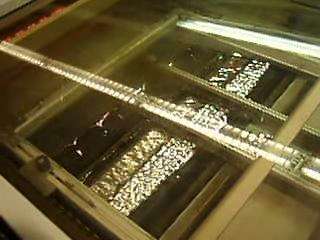Wave soldering

Wave soldering is a bulk soldering process used in the manufacture of printed circuit boards. The circuit board is passed over a pan of molten solder in which a pump produces an upwelling of solder that looks like a standing wave. As the circuit board makes contact with this wave, the components become soldered to the board. Wave soldering is used for both through-hole printed circuit assemblies, and surface mount. In the latter case, the components are glued onto the surface of a printed circuit board (PCB) by placement equipment, before being run through the molten solder wave.
As through-hole components have been largely replaced by surface mount components, wave soldering has been supplanted by reflow soldering methods in many large-scale electronics applications. However, there is still significant wave soldering where surface-mount technology (SMT) is not suitable (e.g., large power devices and high pin count connectors), or where simple through-hole technology prevails (certain major appliances).
Wave solder process

There are many types of wave solder machines; however, the basic components and principles of these machines are the same. The basic equipment used during the process is a conveyor that moves the PCB through the different zones, a pan of solder used in the soldering process, a pump that produces the actual wave, the sprayer for the flux and the preheating pad. The solder is usually a mixture of metals. A typical solder has the chemical makeup of 50% tin, 49.5% lead, and 0.5% antimony.[1]
Fluxing
Flux in the wave soldering process has a primary and a secondary objective. The primary objective is to clean the components that are to be soldered, principally any oxide layers that may have formed.[2] There are two types of flux, corrosive and noncorrosive. Noncorrosive flux requires precleaning and is used when low acidity is required. Corrosive flux is quick and requires little precleaning, but has a higher acidity.[3]
Preheating
Preheating helps to accelerate the soldering process and to prevent thermal shock.[4]
Cleaning
Some types of flux, called "no-clean" fluxes, do not require cleaning; their residues are benign after the soldering process.[5] Typically no-clean fluxes are especially sensitive to process conditions, which may make them undesirable in some applications.[5] Other kinds of flux, however, require a cleaning stage, in which the PCB is washed with solvents and/or deionized water to remove flux residue.
Finish and quality
Quality depends on proper temperatures when heating and on properly treated surfaces.
| Defect | Possible causes | Effects |
|---|---|---|
| Cracks | Mechanical Stress | Loss of Conductivity |
| Cavities | Contaminated surface
Lack of flux |
Reduction in strength
Poor conductivity |
| Wrong solder thickness | Wrong solder temperature
Wrong conveyor speed |
Susceptible to stress
Too thin for current load |
| Poor Conductor | Contaminated solder | Product Failures |
Solder types
Different combinations of tin, lead and other metals are used to create solder. The combinations used depend on the desired properties. The most popular combinations are SAC (Tin(Sn)/Silver(Ag)/Copper(Cu)) alloys and Sn63Pb37 (Sn63A) which is 63% tin, 37% lead. The latter combination is strong, has a low melting range, and melts and sets quickly. Higher tin compositions give the solder higher corrosion resistances, but raise the melting point. Another common composition is 11% tin, 37% lead, 42% bismuth, and 10% cadmium. This combination has a low melting point and is useful for soldering components that are sensitive to heat. Environmental and performance requirements also factor into alloy selection. Common restrictions include restrictions on lead (Pb) when RoHS compliance is required and restrictions on pure tin (Sn) when long term reliability is a concern. [6] [7]
Effects of cooling rate
It is important that the PCBs be allowed to cool at a reasonable rate. If they are cooled too fast, then the PCB can become warped and the solder can be compromised. On the other hand, if the PCB is allowed to cool too slowly, then the PCB can become brittle and some components may be damaged by heat. The PCB should be cooled by either a fine water spray or air cooled to decrease the amount of damage to the board.[8]
Thermal profiling
Thermal profiling is the act of measuring several points on a circuit board to determine the thermal excursion it takes through the soldering process. In the electronics manufacturing industry, SPC (Statistical Process Control) helps determine if the process is in control, measured against the reflow parameters defined by the soldering technologiEs and component requirements.[9] Products like the Solderstar WaveShuttle and the Optiminer have been developed special fixtures which are passed through the process and can measure the temperature profile, along with contact times, wave parallelism and wave heights. These fixture combined with analysis software allows the production engineer to establish and then control the wave solder process.
See also
References
- ↑ Robert H. Todd, Dell K. Allen, Leo Alting (1994). Manufacturing Processes Reference Guide. p. 393.
- ↑ http://www.ipctraining.org/dvd/47c/script.pdf
- ↑ Todd p. 396
- ↑ Michael Pecht (1993). Soldering Processes and Equipment. p. 56.
- 1 2 Giles Humpston, David M. Jacobson (2004). Principles of Soldering. p. 118.
- ↑ Todd p. 395
- ↑ http://www.aimsolder.com/sites/default/files/soldering_handbook_rev_10-13.pdf
- ↑ Todd, Robert H.; Allen, Dell K.(1994). Manufacturing Processes Reference Guide. New York: Industrial Press Inc.
- ↑ http://www.ipc.org/TOC/IPC-7530.pdf
Further reading
- Seeling, Karl (1995). A study of lead-free alloys. AIM, 1, Retrieved April 18, 2008, from http://www.aimsolder.com/techarticles/A%20Study%20of%20Lead-Free%20Solder%20Alloys.pdf
- Biocca, Peter (2005, April 5). Lead-free wave soldering. Retrieved April 18, 2008, from EMSnow Web site: http://www.emsnow.com/npps/story.cfm?ID=10669